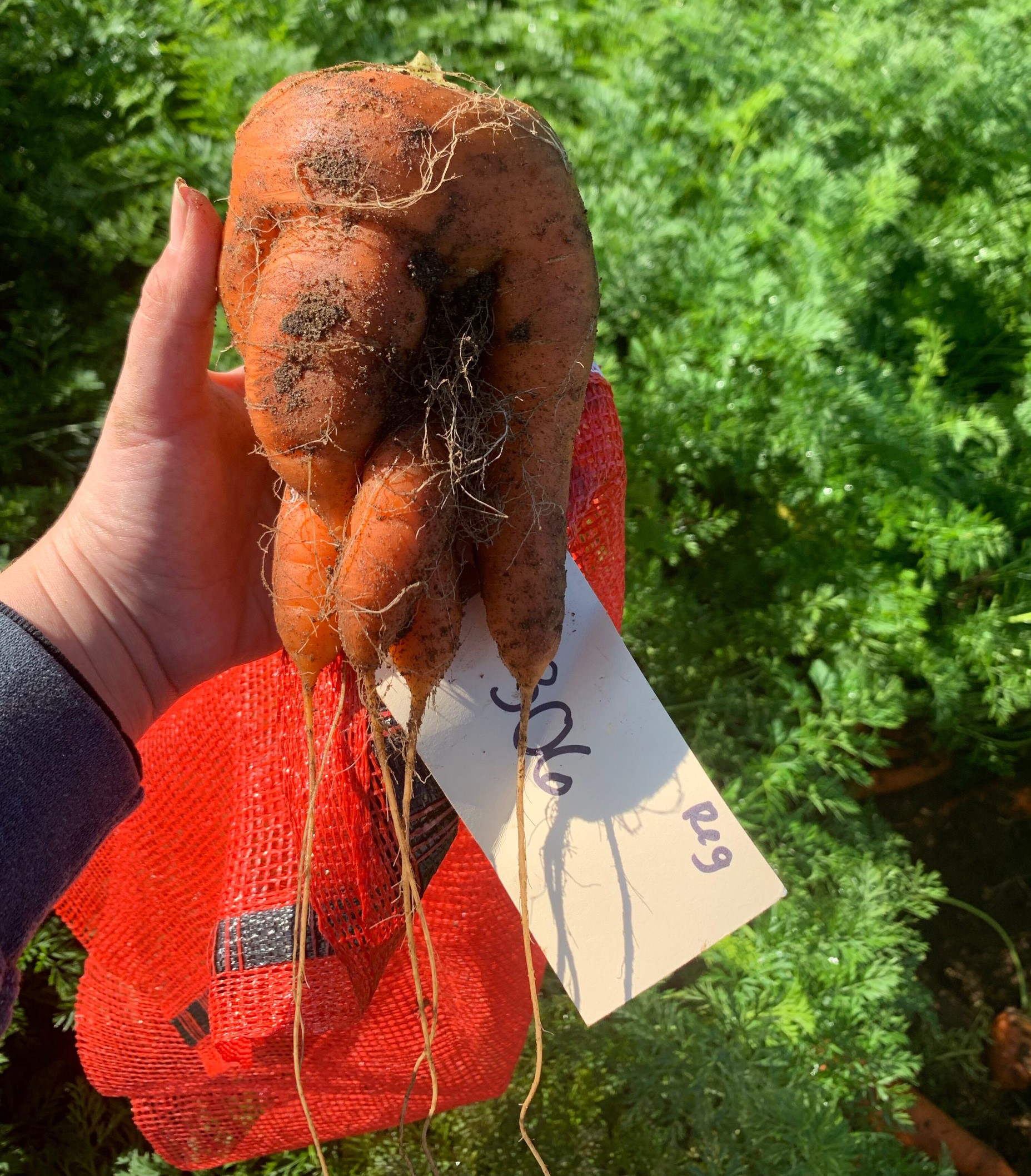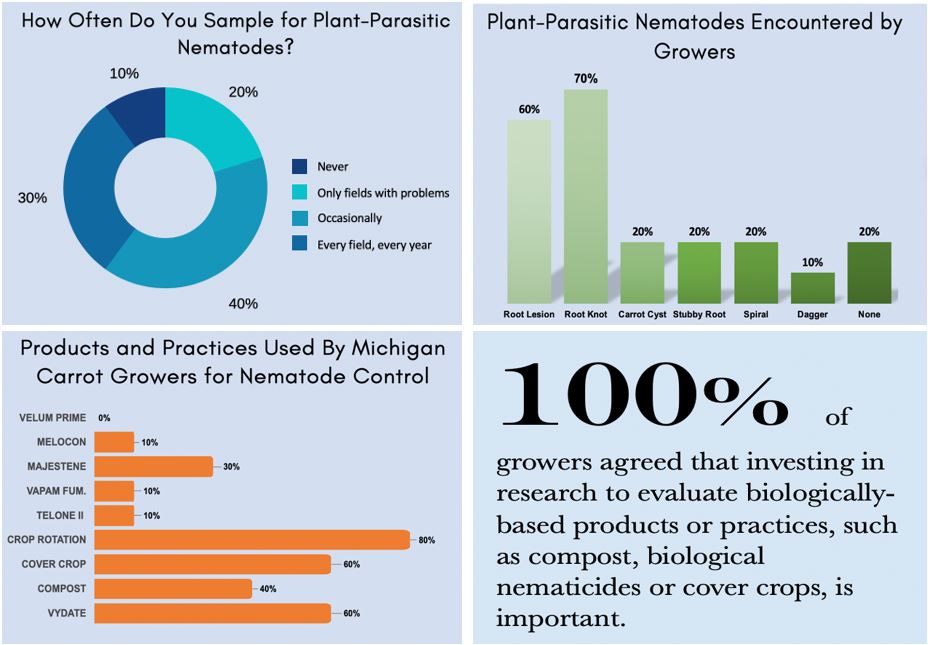Surveying Michigan carrot growers on plant-parasitic nematode control habits
Current control practices and commonly encountered nematodes in Michigan carrot fields.

Introduction
Root lesion nematodes (Pratylenchus spp.) are the third most economically damaging plant-parasitic nematode worldwide. Densities above threshold are associated with stubbing, forking and hairiness in processing carrots. Historically, plant-parasitic nematode studies involving Michigan carrots have focused on controlling the northern root-knot nematode, Meloidogyne hapla, and the carrot cyst nematode, Heterodera carotae. This was largely due to the severe damage produced by both nematodes on root vegetables such as carrot and parsnip.
Past studies on root-knot nematode control were successful and have provided growers with effective cultural and chemical control methods for these pests. One cultural control measure that nematologists have advised is to avoid planting on muck soils, for this facilitates the growth and reproduction of these pests. Some growers then shifted to planting processing carrots in sandier soils. Recently, these sandier soils have been associated with favoring root lesion nematode development and infection. Vydate (active: oxamyl) offers effective control of root lesion nematode. However, due to increasing applicator safety concerns, growers are seeking alternative methods of control such as compost applications, biological nematicides and non- or poor-host cover crop options.

We partnered with the Michigan Carrot Committee to survey Michigan carrot growers on their habits in relation to the future of plant-parasitic nematode research in Michigan.
Survey
In order to learn more about current control methods used for plant-parasitic nematode research, we asked Michigan carrot growers to fill out a short survey. This survey included questions related to how often they soil sampled, what nematodes they have encountered, what products and practices they use for control, and if they consider investing in this research beneficial.
The survey was administered via mail by the Michigan Carrot Committee to Michigan carrot growers, and all grower responses were sent to Michigan State University. By March 25, 2020, 10 responses were received. In this short Michigan State University Extension article, we outline their responses.
Survey questions
- Do you submit soil samples to know your plant parasitic nematode numbers?
- If you have sampled, what type of nematodes have you encountered?
- What products or practices do you use for nematode control?
- Should we be investing in research to evaluate biologically based alternative practices, such as compost, biological nematicides or cover crops?
Results
As of March 2020, 10 grower responses had been received. Growers could indicate multiple answers for question 2 and 3. A vast majority (90%) of growers reported sampling at least fields with problem history, with only one “Never” response. Root-knot nematodes and root lesion nematodes were encountered the most, with 70% and 60%, respectively. The most common current products and practices used were crop rotation (80%), Vydate (60%), cover crop (60%) and compost (40%). Notably, 100% of growers agreed that investing in research evaluating alternative methods was important.
Compost amendments and biological nematicides
Currently, our laboratory has ongoing lab and field trials testing the efficacies of a range of biologically based nematicides and two composts on root lesion nematode control. If successful, these products and practices could be recommended as alternatives to the current grower standard, Vydate (active: oxamyl). Recently, poultry and dairy-based composted manure has shown nematocidal qualities for root lesion nematode in potato systems, according to Cole et al., 2020. Our laboratory is also in the third year of a field trial testing the efficacy of the same compost blend on root lesion in carrots. So far, plots with compost added have had higher yields than other nematicide plots, but this needs to be confirmed before recommendations are made.
Cover cropping for nematode control
As a non-chemical alternative, cover crops including oilseed radish have reduced plant-parasitic nematode populations. To qualify as a good cover crop for the management of plant-parasitic nematodes, the crop should be a poor host for the nematodes thereby lowering the population after incorporation of the crop into the soil. We are evaluating several cultivars of oilseed radish and other selected cover crops to manage root-lesion and root-knot nematodes in carrots as they were the two top ranking nematodes in our grower survey. So far, in growth chamber assays, the oilseed radish ‘Control’, ‘Concorde’, ‘Nitro’, ’Select’ and ‘Dwarf Essex’ rape are promising poor hosts for lesion nematode. Trials investigating cover crops for root-knot nematode are ongoing.
Conclusion
In this MSU Extension article, we dove into the issues that Michigan carrot growers are currently facing with the root lesion nematode. We outlined the current need for research in this area and documented the results of a survey performed by our laboratory in combination with the Michigan Carrot Committee. In the next few years, we will conclude our current trials for these developing products and practices and a clear recommendation will be made for the use of non- or poor-host cover crops, biological and chemical nematicides, and incorporation of composted manures as appropriate measures for root lesion nematode control in carrot systems.
It is always important to test your soil prior to planting to fully understand what nematodes are present within your soil before making management decisions. For sampling instructions and information on where to send samples, visit MSU Plant & Pest Diagnostics. For more information relating to plant-parasitic nematode control in root vegetables, please contact applied nematologist Marisol Quintanilla.



 Print
Print Email
Email





